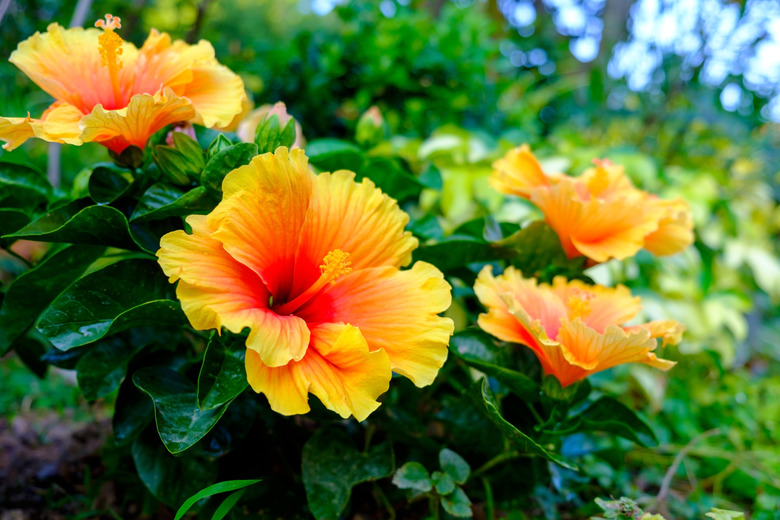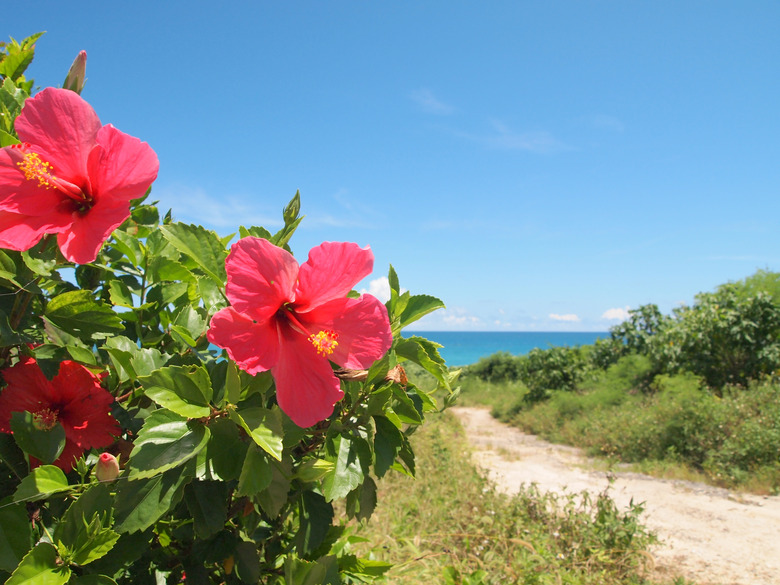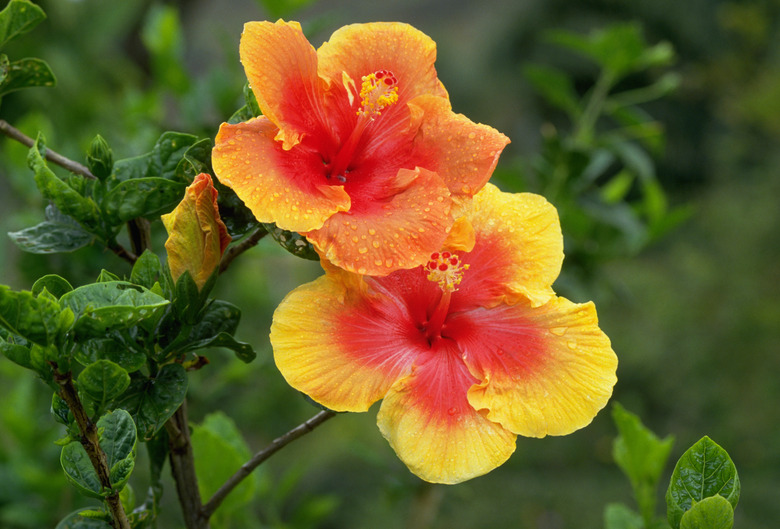How To Grow Tropical Hibiscus
We may receive a commission on purchases made from links.
Sometimes called Chinese hibiscus, the tropical hibiscus (Hibiscus rosa-sinensis, USDA zones 9-11) is a beautiful shrub with glossy leaves and brightly colored blooms that open wide, measuring 4 to 8 inches across. When choosing a hibiscus at the garden center, make sure you get the right plant. Tropical hibiscus is related to but not the same as perennial hibiscus plants such as swamp hibiscus (Hibiscus coccineus, USDA zones 5-9), Eastern rose-mallow (Hibiscus moscheutos, USDA zones 5-9), and cotton rose-mallow (Hibiscus mutabilis, USDA zones 7-9), and it requires different care.
When left to their own devices, tropical hibiscus plants reach heights of up to 10 feet and spread up to 8 feet wide. Only plants grown in warm climates in this plant's perennial range are likely to reach these dimensions, however. Many gardeners grow tropical hibiscus plants in containers and bring them indoors for the winter. This often requires regular pruning to keep the plants small and manageable enough for indoor growing.
Hibiscus flowers come in a wide variety of vivid hues, including red, yellow, pink, orange, peach, salmon, and white. Whatever color they choose, gardeners in all but the warmest climates usually grow tropical hibiscus as an annual plant. It's technically an evergreen perennial but is a warm-weather lover that won't survive the winter in most of the United States.
Best Uses for Hibiscus
Best Uses for Hibiscus
In U.S. Department of Agriculture plant hardiness zones 9 through 11, gardeners often use hibiscus as a natural hedge or privacy screen. It also makes a beautiful specimen plant that works well standing alone in the landscape or as part of a flower bed. In cooler areas, hibiscus often grows as a container plant that graces patios or swimming pool decks in the summer and then serves as a houseplant during the winter.
Hibiscus plants attract both hummingbirds and butterflies, so you may wish to plant them where you can easily watch nature from your window. Note too that hibiscus flowers make excellent decorations. They only last a day, but hibiscus flowers don't need water to keep them from wilting. This makes them much more versatile than other plants when decorating for a special event.
How to Grow Hibiscus
How to Grow Hibiscus
Starting Hibiscus From a Seedling
Starting Hibiscus From a Seedling
To plant your hibiscus plant outdoors, work the soil to a depth of 12 inches, loosening it and removing any rocks or other debris. Dig a planting hole in your loosened soil that's deep enough to accommodate your plant's entire root ball.
Place the hibiscus in the hole and adjust it as needed so that the soil falls at the same place it did in the plant's original container. If you're planting several hibiscus plants, space them 3 to 6 feet apart.
If you're planting your hibiscus in a container, choose one that is no more than twice the size of your plant's root ball. Fill the container about a third of the way with fresh potting soil and then set your hibiscus in the pot. Add more potting soil as needed to cover the plant's roots. The top of the root ball should be fully covered and about 1 inch below the top of the pot when you're done.
Whether you plant in the ground or a container, make sure you water your new hibiscus thoroughly immediately after planting. If desired, you can mulch around the plant to help retain moisture and reduce weeds.
In What Zone Does Hibiscus Grow Best?
In What Zone Does Hibiscus Grow Best?
You can grow a tropical hibiscus plant anywhere, but how you do it varies based on your location. In USDA hardiness zones 9 through 11, you can grow tropical hibiscus outdoors and leave it outside all year.
In colder climates, it's best to grow a hibiscus plant in a container. This allows you to set the plant outside during the summer months but easily move it inside during the winter. Some gardeners simply enjoy the plant as an annual, allowing it to die back during the winter and planting a new hibiscus the next year.
When Should You Plant Hibiscus?
When Should You Plant Hibiscus?
If you're heading straight for the garden, wait until the nighttime temperatures stay above 50 degrees Fahrenheit to plant hibiscus. Container planting can happen at any time, but it's easiest to find young plants in the spring. Most garden centers in cooler climates don't have them available during the winter season.
Soil, Sunlight, and Water Recommendations for Hibiscus
Soil, Sunlight, and Water Recommendations for Hibiscus
Hibiscus plants do best in well-drained, slightly acidic soil with a pH level between 6.5 and 6.8. Don't stress too much about hitting this fairly narrow window, however. You can raise your soil's pH with some lime, but hibiscus plants will do fine in neutral soils if they must.
Although they're willing to negotiate a bit on soil, hibiscus plants demand lots of sunlight. Plants need at least six to eight hours of sunlight per day to thrive. Though they like sun and warmth, hibiscus plants can overheat if the temperature rises above 100 degrees Fahrenheit. Your plant will bounce back when the temperatures cool again, but expect some bud drop and slow flower production during a heat wave.
Water your hibiscus plant daily for the first week after you plant it. During the second week, water every other day. After that, your hibiscus plant needs water when the top inch of soil is dry. This usually amounts to about twice a week during dry weather but check your plants regularly until you get a feel for how quickly the soil dries out. Remember that container-grown plants dry out more quickly and need more-frequent checking.
Hibiscus plants do OK without fertilizer, but consistent fertilizing makes them really pop. For best results, fertilize your plants weekly with a half dose of 17-5-23 fertilizer. During the winter months, cut back to fertilizing every month if you're growing plants outdoors. If you're growing your hibiscus indoors during the winter, withhold fertilizer until new growth emerges in spring.
When scouting a planting spot for your hibiscus, choose an area protected from the wind. Hibiscus flowers are delicate and tear easily in windy conditions. Location also matters indoors. Once they settle in, hibiscus plants don't take kindly to changing conditions. Moving your containers or changing the temperature around them can cause your hibiscus to drop its flowers, as will insufficient light.
Hibiscus plants also benefit from pruning and deadheading. Deadheading will promote more blooms on your hibiscus, but it can feel like a daunting task since hibiscus flowers only last a single day. It's great if you can keep up with your deadheading, but your plant will do just fine if you forget or skip it for a while.
To keep them healthy, prune outdoor hibiscus plants every spring. Remove any dead or diseased stems as well as any that crisscross each other. Prune out about a third of the plant's old wood and about half of its new growth. This keeps the hibiscus compact and bushy rather than leggy.
If you're bringing a large potted plant inside for the winter, you can prune your plant back by as much as half to make it smaller and easier to maneuver. You can usually prune as much as you like as long as you leave a few older leaves and some new growth.
How to Winterize Hibiscus
How to Winterize Hibiscus
Generally, hibiscus plants do fine during winter in zones 9 through 11. On occasion, however, even these warm areas can experience a freeze, and gardeners in zone 9 need to be especially mindful of this. If the weather forecast calls for a temperature dip below 35 degrees, place a thick layer of mulch around the roots of your plants to protect them and keep them warm.
In other areas, saving your hibiscus over the winter means bringing it indoors, ideally placing it where it gets lots of light and the temperature remains at 60 degrees or above. Before bringing your hibiscus indoors for the winter, wash it. Hibiscus plants are notorious for attracting aphids and spider mites, and you don't want these critters infesting your other houseplants.
Using plain water from your garden hose, thoroughly rinse your hibiscus plant, spraying every surface including the underside of the leaves. Do this twice a week for two or three weeks before bringing your plant inside.
Common Pests and Other Problems for Hibiscus
Common Pests and Other Problems for Hibiscus
If you grow hibiscus, it's safe to assume that your plant already has or will have insect pests such as aphids and spider mites. Thrips and mealybugs are also common. If allowed to spiral out of control, these insect issues will result in fewer flowers and bud drop. Luckily, all of these pests are easily eliminated with insecticidal soap. You can also keep these pests at bay by routinely spraying your plants with a shot of water from a garden hose.
Hibiscus may also attract fungus gnats. These tiny gnats look like miniature mosquitoes, and they can pass fungal diseases to plants. If you see these pests flying around your plants, a dose of insecticidal soap will get rid of them.
Common Diseases for Hibiscus
Common Diseases for Hibiscus
If you notice the leaves of a single stem of your hibiscus dying, your plant likely has dieback disease. To solve the problem, look at the affected branch carefully. Somewhere on it, you should see a rotting spot where the stem or flower was broken. When you find it, cut the stem off the plant with clean pruning shears and look at the cut.
If you see dark streaking inside the stem rather than a clean white spot, cut away more of the stem. When you reach clean, healthy tissue, seal the cut with grafting wax to prevent further infection.
More serious than dieback disease is wilt disease. Often fatal, wilt disease affects the entire plant rather than a single stem. To save a sick plant, move its container indoors or provide shade for outdoor plants with a tarp. Remove any yellow leaves from the plants and mist the remaining leaves well but avoid getting the soil wet. Water the plant sparingly only when the soil is dry but mist the plant's leaves every day.
In time, the plant will either die or start to come back. If it comes back, you'll see new green growth. When you do, gradually start exposing the hibiscus to more sunlight again and gradually add fertilizer when watering. If at any point the leaves start to wilt again, go back to the beginning, offering the plant shade and misting again.
Like all plants, hibiscus can fall prey to rots and fungi, such as gray mold, downy mildew, and powdery mildew. You can avoid most of these problems by watering early in the day, raking up spent blooms and keeping the area around the plant free of debris. If your plant does get sick, a copper fungicide will treat most diseases.


